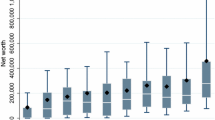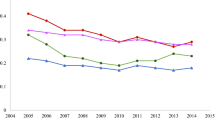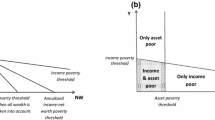Abstract
Wealth is a durable economic resource and it is typically held by individuals over the long-term. Measuring the wealth-type resources held by families, lends important information about the financial security of children. Following others, we argue that wealth provides additional information regarding child well-being, complementing traditional income-based measurements. In this paper, we extend the traditional income measure of child poverty in Canada to include wealth, by defining and presenting two measures of low-assets, or asset poverty. We present a novel estimation of child asset poverty in Canada and the first known estimation of child-level asset poverty more broadly. Focusing specifically on the measurement of asset poverty among children, we find that rates of asset poverty are two to three times as large as rates of income poverty. Prior literature highlights that higher asset levels are strongly associated with better outcomes for children, and families. The high levels of asset poverty in Canada, relative to other comparable nations, has implications for indicators of child well-being and the welfare of Canadian children.


Similar content being viewed by others
Notes
In this paper, we use the terms “low income” and “poverty” interchangeably.
Most countries do not have official poverty measures that are estimated by the state (Citro & Michael, 1995).
As a sensitivity test, we also calculated a net worth variable using the same financial resources plus pensions valued at an ongoing concern basis minus all debts. Results did not vary meaningfully compared to the net worth minus pensions variable.
Results from 1999 were not substantively different compared to 2012. Logistic regression model odds-ratios are presented in the Appendix in Table 6.
References
Albanese, P. (2010). Child poverty in Canada. Don Mills: Oxford University Press.
Alexander, K. L., Entwisle, D. R., & Olson, L. S. (2014). The long shadow: Family background, disadvantaged urban youth, and the transition to adulthood. New York: Russell Sage Foundation https://muse.jhu.edu/book/30869. Accessed 19 Sept 2017.
Aratani, Y., & Chau, M. (2010). Asset poverty and debt among families with children (brief). New York: National Center for Children in Poverty.
Azpitarte, F. (2012). Measuring poverty using both income and wealth: A cross-country comparison between the U.S. and Spain. Review of Income and Wealth, 58(1), 24–50. https://doi.org/10.1111/j.1475-4991.2011.00481.x.
Bauer, T. K., Cobb-Clark, D. A., Hildebrand, V. A., & Sinning, M. G. (2011). A comparative analysis of the nativity wealth gap. Economic Inquiry, 49(4), 989–1007. https://doi.org/10.1111/j.1465-7295.2009.00221.x.
Berger, L. M., & Waldfogel, J. (2011). Economic determinants and consequences of child maltreatment (no. 111). Paris: OECD. https://doi.org/10.1787/5kgf09zj7h9t-en.
Bianchi, S. M. (1999). Feminization and juvenilization of poverty: Trends, relative risks, causes, and consequences. Annual Review of Sociology, 25(1), 307–333. https://doi.org/10.1146/annurev.soc.25.1.307.
Blank, R. M. (2008). Presidential address: How to improve poverty measurement in the United States. Journal of Policy Analysis and Management, 27(2), 233–254. https://doi.org/10.1002/pam.20323.
Bound, J., & Krueger, A. B. (1991). The extent of measurement error in longitudinal earnings data: Do two wrongs make a right? Journal of Labor Economics, 9(1), 1–24. https://doi.org/10.1086/298256.
Brady, D. (2003). Rethinking the sociological measurement of poverty. Social Forces, 81(3), 715–751. https://doi.org/10.1353/sof.2003.0025.
Burton, P., & Phipps, S. (2017). Economic well-being of Canadian children. Canadian Public Policy. https://doi.org/10.3138/cpp.2017-039.
Burton, P., Phipps, S., & Zhang, L. (2012). From parent to child: Emerging inequality in outcomes for children in Canada and the US. Child Indicators Research, 6(2), 363–400. https://doi.org/10.1007/s12187-012-9175-1.
Burton, P., Phipps, S., & Zhang, L. (2014). The prince and the pauper: Movement of children up and down the Canadian income distribution. Canadian Public Policy, 40(2), 111–125. https://doi.org/10.3138/cpp.2012-034.
Caner, A., & Wolff, E. N. (2004). Asset poverty in the United States, 1984–99: Evidence from the panel study of income dynamics. Review of Income and Wealth, 50(4), 493–518. https://doi.org/10.1111/j.0034-6586.2004.00137.x.
Chawla, R. K. (2004). Wealth inequality by province. Perspectives on Labour and Income, 5(9). http://www.statcan.gc.ca/studies-etudes/75-001/archive/2004/5018661-eng.pdf.
Chawla, R. K. (2008). Changes in family wealth. Perspectives on Labour and Income, 15–24. Retrieved from http://www.statcan.gc.ca/pub/75-001-x/2008106/article/10640-eng.htm.
Chen, W.-H., & Corak, M. (2008). Child poverty and changes in child poverty. Demography, 45(3), 537–553. https://doi.org/10.1353/dem.0.0024.
Cobb-Clark, D. A., & Hildebrand, V. A. (2006). The wealth and asset holdings of U.S.-born and foreign-born households: Evidence from SIPP data. Review of Income and Wealth, 52(1), 17–42. https://doi.org/10.1111/j.1475-4991.2006.00174.x.
Corak, M. (2005). Principles and practicalities for measuring child poverty in the rich countries (discussion paper series no. 1579). Bonn: The Institute for the Study of labor.
Crossley, T. F., & Curtis, L. J. (2006). Child poverty in Canada. Review of Income and Wealth, 52(2), 237–260. https://doi.org/10.1111/j.1475-4991.2006.00186.x.
Cunha, F., & Heckman, J. J. (2009). The economics and psychology of inequality and human development. Journal of the European Economic Association, 7(2–3), 320–364. https://doi.org/10.1162/JEEA.2009.7.2-3.320.
Currie, J., & Stabile, M. (2003). Socioeconomic status and child health: Why is the relationship stronger for older children? American Economic Review, 93(5), 1813–1833.
Deere, C. D., & Doss, C. R. (2006). The gender asset gap: What do we know and why does it matter? Feminist Economics, 12, 1–2), 1–50. https://doi.org/10.1080/13545700500508056.
Destin, M., & Oyserman, D. (2009). From assets to school outcomes: How finances shape children’s perceived possibilities and intentions. Psychological Science, 20(4), 414–418. https://doi.org/10.1111/j.1467-9280.2009.02309.x.
Diener, E., & Fujita, F. (1995). Resources, personal strivings, and subjective well-being: A nomothetic and idiographic approach. Journal of Personality and Social Psychology, 68(5), 926–935. https://doi.org/10.1037/0022-3514.68.5.926.
Duncan, G. J., & Brooks-Gunn, J. (1997). Consequences of growing up poor. New York: Russell Sage Foundation.
Duncan, G. J., Ziol-Guest, K. M., & Kalil, A. (2010). Early-childhood poverty and adult attainment, behavior, and health. Child Development, 81(1), 306–325. https://doi.org/10.1111/j.1467-8624.2009.01396.x.
Elliott, W. (2013). The effects of economic instability on children’s educational outcomes. Children and Youth Services Review, 35(3), 461–471. https://doi.org/10.1016/j.childyouth.2012.12.017.
Elliott, W., & Friedline, T. (2013). “You pay your share, we’ll pay our share”: The college cost burden and the role of race, income, and college assets. Economics of Education Review, 33, 134–153. https://doi.org/10.1016/j.econedurev.2012.10.001.
Elliott, W., & Sherraden, M. (2013). Assets and educational achievement: Theory and evidence. Economics of Education Review, 33, 1–7. https://doi.org/10.1016/j.econedurev.2013.01.004.
Elliott, W., Friedline, T., & Nam, I. (2013). Probability of living through a period of economic instability. Children and Youth Services Review, 35(3), 453–460. https://doi.org/10.1016/j.childyouth.2012.12.014.
Emmons, W. R., & Noeth, B. J. (2015). Education and wealth (no. 2). Federal Reserve Bank of St. Louis.
Felligi, I. P. (1997). On poverty and low income. Statistics Canada. http://www.statcan.gc.ca/pub/13f0027x/13f0027x1999001-eng.htm?contentType=application%2Fpdf.
Fisher, M., & Weber, B. A. (2004). Does economic vulnerability depend on place of residence? Asset poverty across metropolitan and nonmetropolitan areas. The Review of Regional Studies, 34(2), 137–155.
Foster, J., Greer, J., & Thorbecke, E. (2010). The Foster–Greer–Thorbecke (FGT) poverty measures: 25 years later. The Journal of Economic Inequality, 8(4), 491–524. https://doi.org/10.1007/s10888-010-9136-1.
Gershoff, E. T., Aber, J. L., Raver, C. C., & Lennon, M. C. (2007). Income is not enough: Incorporating material hardship into models of income associations with parenting and child development. Child Development, 78(1), 70–95. https://doi.org/10.1111/j.1467-8624.2007.00986.x.
Gjertson, L. (2014). Emergency saving and household hardship. Journal of Family and Economic Issues, 37, 1–17. https://doi.org/10.1007/s10834-014-9434-z.
Grinstein-Weiss, M., Shanks, T. R. W., Manturuk, K. R., Key, C. C., Paik, J.-G., & Greeson, J. K. P. (2010). Homeownership and parenting practices: Evidence from the community advantage panel. Children and Youth Services Review, 32(5), 774–782. https://doi.org/10.1016/j.childyouth.2010.01.016.
Grinstein-Weiss, M., Shanks, T. R. W., & Beverly, S. G. (2014). Family assets and child outcomes: Evidence and directions. Future of Children, 24(1), 147–170.
Haurin, D. R., Parcel, T. L., & Haurin, R. J. (2002). Does homeownership affect child outcomes? Real Estate Economics, 30(4), 635–666. https://doi.org/10.1111/1540-6229.t01-2-00053.
Haveman, R., & Wolff, E. N. (2004). The concept and measurement of asset poverty: Levels, trends and composition for the U.S., 1983–2001. The Journal of Economic Inequality, 2(2), 145–169. https://doi.org/10.1007/s10888-005-4387-y.
Hertzman, C., & Boyce, T. (2010). How experience gets under the skin to create gradients in developmental health. Annual Review of Public Health, 31(1), 329–347. https://doi.org/10.1146/annurev.publhealth.012809.103538.
Hill, M. S., & Duncan, G. J. (1987). Parental family income and the socioeconomic attainment of children. Social Science Research, 16(1), 39–73. https://doi.org/10.1016/0049-089X(87)90018-4.
Huang, J. (2013). Intergenerational transmission of educational attainment: The role of household assets. Economics of Education Review, 33, 112–123. https://doi.org/10.1016/j.econedurev.2012.09.013.
Huang, J., Sherraden, M., Kim, Y., & Clancy, M. (2014). Effects of child development accounts on early social-emotional development: An experimental test. JAMA Pediatrics. https://doi.org/10.1001/jamapediatrics.2013.4643.
Jäntti, M., Sierminska, E., & Smeeding, T. M. (2008). How is household wealth distributed? Evidence from the Luxembourg wealth study. In: Growing unequal? Income distribution and poverty in OECD countries (pp. 253–78). Paris: OECD Publishers.
Jenson, J. (2004). Changing the paradigm: Family responsibility or investing in children. The Canadian Journal of Sociology, 29(2), 169–192. https://doi.org/10.1353/cjs.2004.0025.
Keister, L. A., & Moller, S. (2000). Wealth inequality in the United States. Annual Review of Sociology, 26(1), 63–81. https://doi.org/10.1146/annurev.soc.26.1.63.
Killewald, A., Pfeffer, F. T., & Schachner, J. N. (2017). Wealth inequality and accumulation. Annual Review of Sociology, 43(1), 379–404. https://doi.org/10.1146/annurev-soc-060116-053331.
Kim, K., & Kim, Y. M. (2013). Asset poverty in Korea: Levels and composition based on Wolff’s definition. International Journal of Social Welfare, 22(2), 175–185. https://doi.org/10.1111/j.1468-2397.2011.00869.x.
King, G., Tomz, M., & Wittenberg, J. (2000). Making the most of statistical analyses: Improving interpretation and presentation. American Journal of Political Science, 44, 341–355.
LIS Cross-National Data Center in Luxembourg. (n.d.). LWS list of datasets. http://www.lisdatacenter.org/our-data/lws-database/documentation/lws-list-of-datasets/.
Luxembourg Income Study. (2012). Self-Teaching Package. http://www.lisdatacenter.org/wp-content/uploads/2011/03/C3-3-6-3-self-teaching-stata.pdf.
Maggi, S., Irwin, L. J., Siddiqi, A., & Hertzman, C. (2010). The social determinants of early child development: An overview. Journal of Paediatrics and Child Health, 46(11), 627–635. https://doi.org/10.1111/j.1440-1754.2010.01817.x.
Magnuson, K. A., & Votruba-Drzal, E. (2009). Enduring influences of childhood poverty. In M. Cancian & S. H. Danziger (Eds.), Changing poverty, changing policies (pp. 153–179). New York: Russell Sage Foundation.
McEwen, A., & Stewart, J. M. (2014). The relationship between income and children’s outcomes: A synthesis of Canadian evidence. Canadian Public Policy, 40(1), 99–109.
Midgley, J. (1995). Social development: The developmentalist perspective in social welfare. Thousand Oaks: SAGE Publications Inc..
Modigliani, F. (1966). The life cycle hypothesis of saving, the demand for wealth and the supply of capital. Social Research, 160–217.
Mood, C. (2010). Logistic regression: Why we cannot do what we think we can do, and what we can do about it. European Sociological Review, 26(1), 67–82. https://doi.org/10.1093/esr/jcp006.
Nam, Y., Huang, J., & Sherraden, M. (2008). Asset definitions. In S.-M. McKernan & M. Sherraden (Eds.), Asset building and low-income families (pp. 1–32). Washington, DC: The Urban Institute Press.
Oliver, M. L., & Shapiro, T. M. (1990). Wealth of a nation. American Journal of Economics and Sociology, 49(2), 129–151. https://doi.org/10.1111/j.1536-7150.1990.tb02268.x.
Oyserman, D. (2013). Not just any path: Implications of identity-based motivation for disparities in school outcomes. Economics of Education Review, 33, 179–190. https://doi.org/10.1016/j.econedurev.2012.09.002.
Oyserman, D. (2015). Pathways to success through identity-based motivation. New York: Oxford University Press.
Pampalon, R., & Raymond, G. (2000). A deprivation index for health and welfare planning in Quebec. Chronic Diseases in Canada, 21(3), 104–113.
Pampalon, R., Hamel, D., Gamache, P., & Raymond, G. (2009). A deprivation index for health planning in Canada. Chronic Diseases in Canada, 29(4), 178–191.
Pascoe, J. M., Wood, D. L., Duffee, J. H., Kuo, A., Committee on Psychosocial Aspects of Child and Family Health, & Council on Community Pediatrics (2016). Mediators and adverse effects of child poverty in the United States. Pediatrics, 137(4), e20160340. https://doi.org/10.1542/peds.2016-0340.
Pensions and Wealth Surveys Section, Statistics Canada. (1999). 1999 Survey of Financial Security: public use microdata file user guide, (no. 13F0026MIE — No. 002) (p. 28). Ottawa: Statistics Canada http://www23.statcan.gc.ca/imdb-bmdi/document/2620_DLI_D3_T22_V2-eng.pdf.
Pensions and Wealth Surveys Section, Statistics Canada. (2005). 2005 Survey of Financial Security: Public use microdata file user guide, (no. 13F0026MIE — No. 001) (p. 31). Ottawa: Statistics Canada http://www23.statcan.gc.ca/imdb-bmdi/document/2620_DLI_D3_T22_V2-eng.pdf.
Pensions and Wealth Surveys Section, Statistics Canada. (2015). 2012 Survey of Financial Security: public use microdata file user guide (p. 29). Ottawa: Statistics Canada http://sda.chass.utoronto.ca/sdaweb/dli/sfs/sfs12/more_doc/SFS2012ENgid.pdf.
Pfeffer, F. T. (2016). Growing wealth gaps in education (pp. 16–869). Ann Arbor: Population studies center, University of Michigan http://www.psc.isr.umich.edu/pubs/pdf/rr16-869.pdf.
Pfeffer, F. T., & Killewald, A. (2015). How rigid is the wealth structure and why? Inter- and multi-generational associations in family wealth (pp. 15–845). Ann Arbor: Population studies center, University of Michigan http://www.psc.isr.umich.edu/pubs/pdf/rr15-845.pdf.
Piketty, T. (2014). Capital in the twenty-first century. (A. Goldhammer, Trans.). Cambridge: Belknap Press of Harvard University Press.
Plante, C., & van den Berg, A. (2011). How much poverty can’t the government be blames for? A counterfactual decomposition of poverty rates in Canada’s largest provinces. In: Statistiques sociales, pauvreté et exclusion sociale: hommage à Paul Bernard (pp. 163–175). Montreal: Les Presses de l’Université de Montréal.
Rainwater, L., & Smeeding, T. M. (2003). Poor kids in a rich country: America’s children in comparative perspective. Russell Sage Foundation.
Ravallion, M. (1996). Issues in measuring and modelling poverty. Economic Journal, 106(438), 1328–1343.
Ravallion, M. (2010). The debate on globalization, poverty, and inequality: Why measurement matters 1. In S. Anand, P. Segal, & J. E. Stiglitz (Eds.), Debates on the measurement of global poverty (pp. 25–41). Oxford: Oxford University Press http://www.oxfordscholarship.com/view/10.1093/acprof:oso/9780199558032.001.0001/acprof-9780199558032-chapter-2.
Ravallion, M., Chen, S., & Sangraula, P. (2009). Dollar a day revisited. The World Bank Economic Review, 23(2), 163–184. https://doi.org/10.1093/wber/lhp007.
Robson, J. (2013). Does Canada have a hidden “wealthfare” system? The policy history and household use of tax-preferred savings instruments in Canada. Ottawa: Carleton University.
Rothwell, D. W., & Han, C.-K. (2010). Exploring the relationship between assets and family stress among low-income families. Family Relations, 59(4), 396–407.
Rothwell, D. W., & Robson, J. (in press). The prevalence and composition of asset-poverty in Canada: 1999, 2005, and 2012. International Journal of Social Welfare. https://doi.org/10.1111/ijsw.12275/full.
Ruel, E., & Hauser, R. M. (2013). Explaining the gender wealth gap. Demography, 50(4), 1155–1176. https://doi.org/10.1007/s13524-012-0182-0.
Sandstrom, H., & Huerta, S. (2013). The negative effects of instability on child development: A research synthesis. Washington, DC: The Urban Institute http://www.urban.org/publications/412899.html.
Schneider, D. (2011). Wealth and the marital divide. American Journal of Sociology, 117(2), 627–667. https://doi.org/10.1086/661594.
Sen, A. (1976). Poverty: An ordinal approach to measurement. Econometrica, 44(2), 219–231. https://doi.org/10.2307/1912718.
Sen, A. (1983). Poor, relatively speaking. Oxford Economic Papers, 35(2), 153–169.
Sen, A. (1999). Development as freedom, first anchor books edition. New York: Knopf.
Shanks, T. R. W. (2007). The impacts of household wealth on child development. Journal of Poverty, 11(2), 93–116. https://doi.org/10.1300/J134v11n02_05.
Shaprio, T., & Oliver, M. (2006). Black wealth/white wealth: A new perspective on racial inequality, 10th Anniversary Edition. New York: Routledge.
Sherraden, M. (1991). Assets and the poor: A new American welfare policy. Armonk: M.E. Sharpe.
Spilerman, S. (2000). Wealth and stratification processes. Annual Review of Sociology, 26(1), 497–524. https://doi.org/10.1146/annurev.soc.26.1.497.
StataCorp. (2015). Stata statistical software: Release 14 (Version 14.1 SE). College Station: StataCorp LP.
Statistics Canada. (2001). Survey of Financial Security interview questionnaire, (no. 13F0026MIE-01001) (p. 86). Ottawa: Statistics Canada.
Statistics Canada. (2005). Guide to the Labour Force Survey, (no. 71–543–GIE) (p. 34). Ottawa: Statistics Canada http://www.statcan.gc.ca/pub/71-543-g/71-543-g2005001-eng.pdf.
Statistics Canada. (2013). Table 202–0802: Persons in low income families, annual. Ottawa: Statistics Canada http://www5.statcan.gc.ca/cansim/a05.
Statistics Canada. (2017). Table 109–5355 : Estimates of population (2011 Census and administrative data), by age group and sex for July 1st, Canada, provinces, territories, health regions (2015 boundaries) and peer groups, annual (number)(1,2,3,4). http://www5.statcan.gc.ca/cansim/a47.
Townsend, P. (1954). Measuring poverty. The British Journal of Sociology, 5(2), 130–137. https://doi.org/10.2307/587651.
UNICEF. (2012). Measuring child poverty (UNICEF Innocenti research Centre report card). Florence: UNICEF Innocenti Research Centre http://www.unicef-irc.org/publications/pdf/rc10_eng.pdf.
UNICEF Office of Research. (2014). Children of the recession: The impact of the economic crisis on child well-being in rich countries. Florence: UNICEF http://www.unicef-irc.org/publications/pdf/rc12-eng-web.pdf.
Vespa, J., & Ii, M. A. P. (2011). Cohabitation history, marriage, and wealth accumulation. Demography, 48(3), 983–1004. https://doi.org/10.1007/s13524-011-0043-2.
Zagorsky, J. L. (2005). Marriage and divorce’s impact on wealth. Journal of Sociology, 41(4), 406–424. https://doi.org/10.1177/1440783305058478.
Author information
Authors and Affiliations
Corresponding author
Appendix
Appendix
Rights and permissions
About this article
Cite this article
Blumenthal, A., Rothwell, D.W. The Measurement and Description of Child Income and Asset Poverty in Canada. Child Ind Res 11, 1907–1933 (2018). https://doi.org/10.1007/s12187-017-9525-0
Accepted:
Published:
Issue Date:
DOI: https://doi.org/10.1007/s12187-017-9525-0




